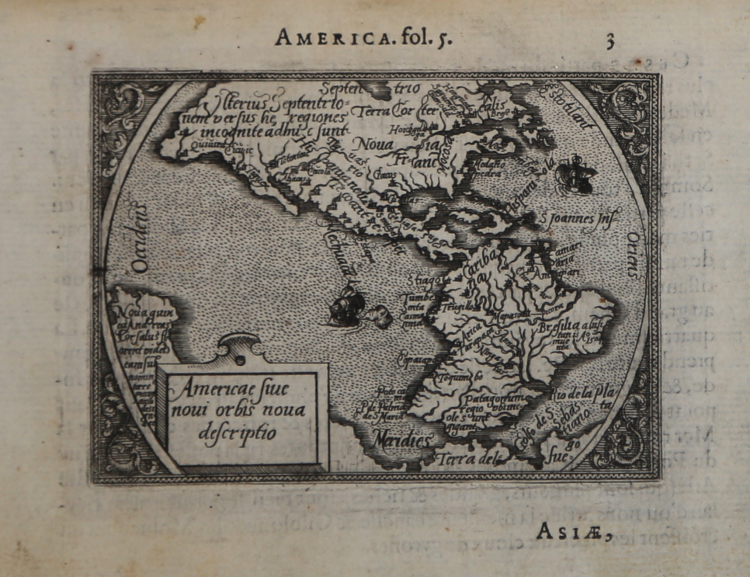



| Reference: | S33909 |
| Author | Abraham ORTELIUS - Philip GALLE |
| Year: | 1577 ca. |
| Zone: | The Americas |
| Printed: | Antwerpen |
| Measures: | 110 x 80 mm |


| Reference: | S33909 |
| Author | Abraham ORTELIUS - Philip GALLE |
| Year: | 1577 ca. |
| Zone: | The Americas |
| Printed: | Antwerpen |
| Measures: | 110 x 80 mm |
Miniature map published taken from the second French edition of Le Miroir du Monde, published by Galle & Heyns in 1583, printed by Plantin and first publsihed in 1577 under the title Spieghel der werelt.
Le Miror du Monde is the French transaltion of the Duch poems Spieghel der Werelt, the first modern pocket-atlas, published by Philip Galle with text by Peeter Heyns in 1577, based on Abraham Ortelius’ Theatrum Orbis Terrarum. The maps were drawn and engraved by Galle.
Between 1577 & 1598 Galle issued 11 editions, all printed by Christopher Plantin.
“The concept of this atlas, known more widely as the Epitome, was to produce a reduced format version of the successful folio atlas of Abraham Ortelius first published in 1570. Philippe Galle cut the plates and Pieter Heyns provided the text in verse. It proved to be as popular as its original. This particular map was a reduction of the folio America map in the 1570 edition of the Theatrum. It has the same bulges to the coastlines of south- west South America and the north-west of North America.
There were eleven editions using this plate before it was replaced with another.
All issues were in oblong format with the exception of the Favolium edition of 1585. This was published in a bigger format to incorporate the larger maps which had been previously folded in; the rest of the other plates are set within the text. In this issue the America map is printed on the reverse of that of the world. The 1598 edition contained a new plate. In Brescia, 1598, another series of reduced versions of the folio maps of Ortelius was published. In 1601 a competitive edition was also produced in Antwerp; the maps were cut by Ambrosius and Ferdinand Arsenius with text provided by Michel Coignet.” (Burden " The Mapping of North America", p. 61).
Copperplate, very good condition.
Bibliografia:
Burden "The Mapping of North America", pp. 61-62, n. 48; Koeman 331:12; Phillips 387; G. King, Miniature Antique Maps, pp. 60-61.
Abraham ORTELIUS - Philip GALLE (Haarlem, 1537 - Anversa, 1612)
|
Draughtsman, engraver, publisher, print dealer, writer and historian. It is possible that he was a pupil in Haarlem of Dirk Volkertsz. Coornhert, but more than likely he was trained in the Antwerp workshop of Hieronymous Cock, who published Galle’s first prints in 1557 and for whom he worked for many years. Shortly after 1557 Philip Galle started his own publishing and print business, for which he travelled extensively: in 1560–61 he visited the southern Netherlands, France, Germany and Italy. After 1564 he settled in Antwerp, where he acquired citizenship in 1571, the same year in which he became a master in the city’s Guild of St Luke. He served as dean of the guild from 1585 to 1587. His documented pupils were H. van Doort in 1580, Karel van Mallery (1571–1635) in 1586, Jean-Baptiste Barbé (1578–1649) in 1594 and Peter Backereel (d 1637) in 1605. Others working at the workshop and publishing house included Philip’s sons Theodor and Cornelis, his son-in-law Adriaen Collaert, pupils van Mallery and Barbé, the Wierix brothers, Hendrick Goltzius, Crispijn de Passe I and other members of the Collaert family.
|
Abraham ORTELIUS - Philip GALLE (Haarlem, 1537 - Anversa, 1612)
|
Draughtsman, engraver, publisher, print dealer, writer and historian. It is possible that he was a pupil in Haarlem of Dirk Volkertsz. Coornhert, but more than likely he was trained in the Antwerp workshop of Hieronymous Cock, who published Galle’s first prints in 1557 and for whom he worked for many years. Shortly after 1557 Philip Galle started his own publishing and print business, for which he travelled extensively: in 1560–61 he visited the southern Netherlands, France, Germany and Italy. After 1564 he settled in Antwerp, where he acquired citizenship in 1571, the same year in which he became a master in the city’s Guild of St Luke. He served as dean of the guild from 1585 to 1587. His documented pupils were H. van Doort in 1580, Karel van Mallery (1571–1635) in 1586, Jean-Baptiste Barbé (1578–1649) in 1594 and Peter Backereel (d 1637) in 1605. Others working at the workshop and publishing house included Philip’s sons Theodor and Cornelis, his son-in-law Adriaen Collaert, pupils van Mallery and Barbé, the Wierix brothers, Hendrick Goltzius, Crispijn de Passe I and other members of the Collaert family.
|